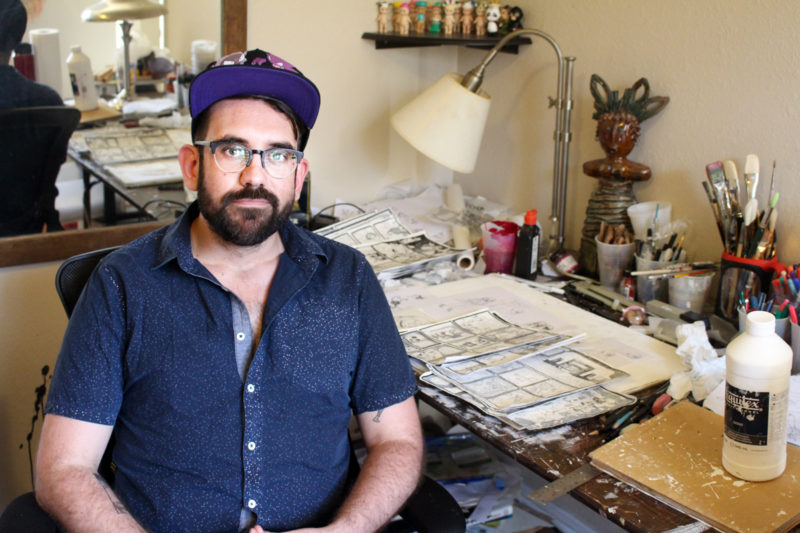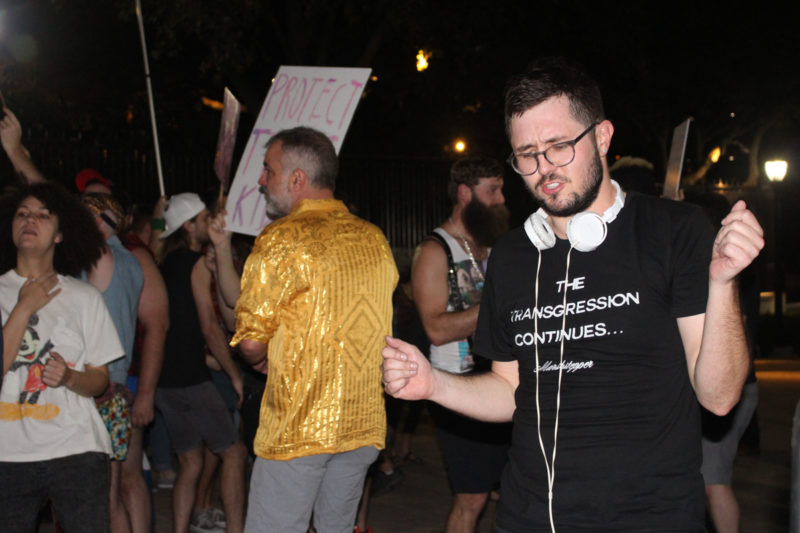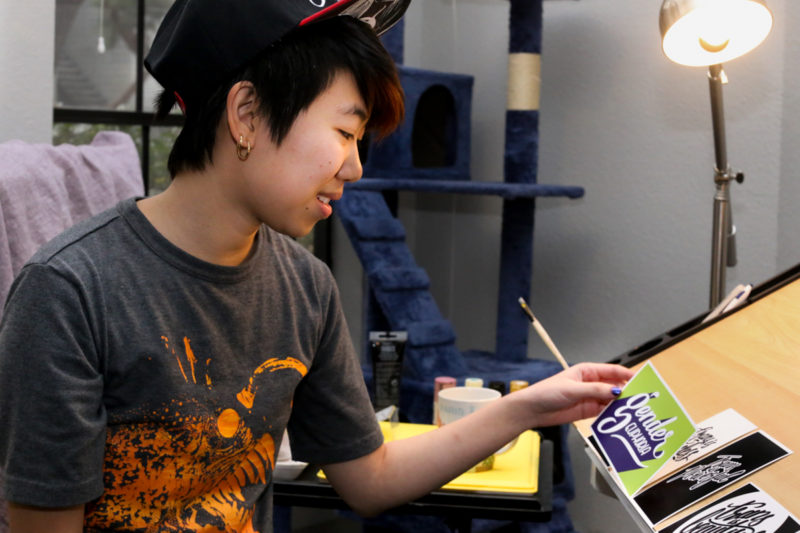Austin Trans and Queer Artists Seek Visibility Amid Intolerance
By César López Linares
Reporting Texas

David Tarafa, a Miami-born graphic artist, created the “Beth Comics” when he was just a kid. Characters from the series were featured on the poster he designed for the “Queer Dance Freakout” protest, last February. César E. López Linares/ Reporting Texas
When Austin graphic artist David Tarafa agreed to create the promotional poster for a protest against a bathroom bill backed by some Texas lawmakers, he knew he had the right concept.
Tarafa drew a poster based on his most precious creation, “Beth Comics,” a queer-erotic comic book he started developing when he was just a kid and first became aware of his sexuality.
In February, LGBT activists used his poster to publicize the demonstration at the governor’s mansion to protest the state bill that would force people on college campuses and in government buildings to use bathrooms that correspond to the sex listed on their birth certificates.

Jeremy Von Stilb is an Austin-based DJ, filmmaker and advocate for LGBTQ rights. He assisted in organizing the “Queer Dance Freakout.” This demonstration — held outside of the historic Texas Governor’s mansion — protested what many deem the “anti-Transgender” Texas Bathroom bill. César E. López Linares/Reporting Texas
Tarafa used diverse characters – a girl, a transgender man of color, a shape-shifter woman, a muscular one-eyed cyborg and a giant mutant butterfly – and portrayed them in a protest scene looking happy, dancing and showing affection to each other, he explained.
The poster became popular on social media and helped attracted more than 100 people to the protest. Many of the attendees reflected the same diversity and irreverence featured in Tarafa’s poster.
Many Austin queer and transgender artists believe that art such as Tarafa’s help their community gain visibility in what they consider to be increasingly violent and intolerant times. Eight transgender people, all transgender women of color, have been killed nationwide this year, according to GLAAD, an LGBT media monitoring group.
Along with the bathroom bill, Texas legislators are considering bills that propose to bar the state from enforcing the U.S. Supreme Court’s same-sex marriage ruling and to make public schools disclose students’ sexual orientation to their parents.
“It is really sad and terrible that there are bigots that want to portray (transgender) people as dangerous people, when the reality is that they are one of the most vulnerable populations right now, especially (transgender) women of color,” said Tarafa, who was born in Miami and has been living in Austin for more than 10 years.
Recently, several prominent U.S. art galleries have featured gay and transgender art events. This year the Museum of the City of New York presented “Gay Gotham,” an exhibit that explored LGBT artistic subcultures of the 20th century, while the Leslie-Lohman Museum of Gay and Lesbian Art in New York inaugurated its expanded space with a collection of art pieces about different themes of queer history. In addition, the first Museum of Trans History and Art in the country opened in San Francisco in 2013.
Austin is also taking steps to promote LGBT equality and has started giving more important spaces to local queer and transgender artists, according to area artists.
An estimated 1.4 million adults identify as transgender in the U.S., according to a survey by The Williams Institute of the UCLA School of Law. Texas has the fifth largest transgender population with about 125,350 people.
“Art is giving visibility to a group of people that have often times been swept under the rug or ignored even within the gay communities. Making images that are striking and are demanding attention is like saying, ‘You will not ignore me,’” said Jeremy Von Stilb, an Austin queer filmmaker and performance producer.
Last September, transgender artist Drew Riley presented Austin’s first Gender Unbound Art Fest, an event where transgender, intersex and gender nonconforming artists displayed their work at Soma Vida, a yoga studio on East Cesar Chavez Street.
Riley’s one-day festival, which was funded in large part by $3,750 from the city of Austin Cultural Arts Division, displayed portraits, illustrations and messages not often seen in general media.
“If you walk into a museum, you can see paintings of cisgender people looking beautiful, being themselves,” said Dallas trans non-binary artist Jae Lin, a member of the organizing committee whose work was exhibited in the Gender Unbound Art Fest.

Jae Lin, from Dallas, is a trans non-binary artist who creates “art about depression, pride, anger, trauma, and happiness,” according to Lin’s website. The project includes snapback hats and handbound journals. Lin started the Doodle Me Alive Project that celebrates and encourages the LGBTQ community. Kara Henderson/Reporting Texas
The term cisgender refers to a person whose chosen gender identity aligns with the sex assigned at birth, while non-binary applies to a person who does not identify as male or female.
“But you don’t really see transgender people or transgender bodies reflected in media,” Lin said. “These transgender artists are taking it upon them to really portrait transgender people in a dignified way.”
Queer artists interviewed for this story said that portraits of transgender bodies and similar work can be potentially shocking for some conservative audiences, but they also know that this art can educate people about the conflicts queer and transgender people face.
“The transgender artists are always the most daring and the most boundary-pushing,” Von Stilb said. “Their daily experiences can be really terrifying, so I see that channeled into their work in really amazing and radical ways.”
Austin has featured queer arts events in the past such as “Gay Bi Gay Gay,” the LGBT art and music section of SXSW, and the summer camp and queer performance series “Camp Camp.”
But while gay and transgender art scenes in other U.S. cities frequently have support from government or private institutions, Austin still depends on artists creating their own spaces in backyards and small venues, like Riley did with the Gender Unbound Art Festival.
“All of that creates a space, not just for queer art, but for ideas that you might be not able to express if you were more institutionalized, if you were in Hollywood or these other spaces where you have to answer to somebody,” said Curran Nault, a University of Texas at Austin professor and expert in experimental media, discourse of the body and sexuality art festivals. “There’s more freedom here. Austin has always been a space for queer creativity and also increasingly transgender creativity.”
Even with the success of Gender Unbound Art Fest, its organizers are struggling to obtain a second City of Austin grant for the 2017 edition. Now they are trying to get resources through crowdfunding web sites.
“Stuff like that costs money,” Jae Lin said. “We don’t see a lot of trans projects being funded in Austin. Art requires funding wherever you are in the world. Gender Unbound was awesome but was put on by one non-profit.”
However their art is being consumed, local LGBT artists believe that pushing their work is a good way to fight for their rights. Specifically for transgender individuals, art is a way to react to a world that tends to force them into the shadows.
“Art is always an activist practice, especially when it is being made by people who run the margins, because they are told to keep quiet, to not tell their stories, to stay invisible,” Nault said. “For transgender folks, to create art is to say, ‘We exist, I won’t be silent, our stories matter.’ Regardless of the content, art is always political and kind of rebellious. Art is the first key to visibility because it’s about not just materializing things, but also getting people to think about issues.”